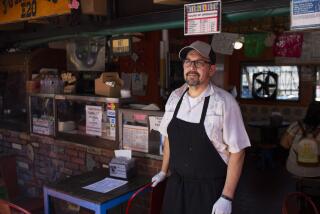Cash-Poor? Entrepreneurial Approaches to Accessing Capital
Entrepreneurship is about creative solutions to common problems. Business owners know to apply creativity to their business concepts, but they sometimes forget to apply it to running their business and obtaining financing.
A common problem for many small businesses is getting access to capital when they don’t have equity holdings, collateral or three years of profitable financial statements. Here are some creative ways to deal with this problem, suggested by small-business consultant Debra Esparza.
* Equipment leasing and short-term rentals: Instead of having to put 20% to 30% down to buy equipment using a conventional loan, leasing often allows a business owner to spend less money upfront and provides more flexibility to exchange equipment when a new model is introduced.
To lease, a business owner needs good credit and sometimes financial statements, proof of insurance and 5% to 10% of the purchase price upfront. Leases typically run for one to five years, and short-term rentals are for a few days to a month. Leases usually suit business owners who use special equipment on an ongoing basis, and rentals work best for owners who need equipment for a month or less.
Leases can take various forms. In an operating lease, the leasing company owns the equipment and provides insurance, repairs and maintenance. In a financial lease, those items are taken care of by the small-business owner who leases the equipment.
Both these types of leases can also be closed-end or open-end. In a closed-end arrangement, the lease ends in a specific time period, with a predetermined, residual payment that allows the person leasing to buy the equipment. An open-end agreement also sets a residual amount, but compares it with the fair-market value of the equipment. If the equipment has declined in value below the residual amount, the person leasing must pay the difference.
When leasing equipment, it’s important to know which type of agreement you’re entering. In a closed-end agreement, you can end up owning the equipment by paying a lump sum at the end of the lease. In an open-end agreement, you can owe a lump sum but not own the equipment.
Another consideration is that leasing equipment may appear to cost more over the long term than buying outright. Add the costs under a lease--down payment and total monthly lease payments--and compare the total to a loan--down payment, loan interest and cost of the equipment itself--to decide which arrangement suits you best.
A business owner should compare various leasing arrangements to get the best deal. Owners also should make sure their business insurance policy covers the lease, or they should buy insurance from the leasing company. Finally, insurance costs for leasing often are higher than the cost to the business owner who owns the equipment outright. That’s because the leasing company wants to make sure insurance covers replacement costs.
* Factoring: Using your accounts receivable as collateral, you can get, in essence, an advance from a factor. That means you receive the money faster than if you waited until your client pays the bill for completed work.
In factoring, your financial statement is not as important as the financial condition of the company that owes you money. Most factors pay only on accounts receivable and not on inventory or orders. Some industries, such as apparel, are built on factoring.
It works like this: Say a small company is owed $50,000 from a corporation but needs money now to continue operations. The factor would pay $20,000 to $30,000 to the company, then collect on the money owed by the company’s client. Once paid, the factor keeps as a fee about 5% per month on the total amount, calculated from the date of the advance to the date full payment is received. The factor subtracts the advance paid previously, plus the interest, and gives the company the difference.
There are two common factoring arrangements: “With recourse” means that if the company that owes money to the small-business owner doesn’t pay, the factor can legally require the business owner to pay the amount. “Without recourse” means that the factor can’t collect from the small-business owner if the company doesn’t pay.
At first glance, factoring may seem like a good arrangement, but the interest rate is extremely high--5% a month, for example, would quickly add up to 60% in a year. Because many small businesses operate on slim profit margins of 4% or 5%, factoring can eat deeply into profit over time. Use factoring only in special situations and manage it carefully, Esparza advised.
* Collateral lenders: Pawn shops are an often overlooked source of money because of their reputation as lenders of last resort. But they are a viable resource for individuals to obtain money on personal assets that otherwise cannot be secured as collateral for a loan. One small-business owner used his wife’s fur coat and jewelry to secure financing from a pawn shop after banks turned him down for traditional loans, Esparza said.
Pawn shops pay about half the value of the items and expect them to be reclaimed for between half and full price. Pawn shops are not allowed to charge interest.
* Trade Credit With Suppliers: As mentioned in a previous column, trade credits can free up operating dollars by giving business owners leeway in paying bills. It is used as the primary source of outside financing by nearly 70% of all businesses, according to recent studies, which also show that trade credits are used first before businesses get loans or equity financing.
Basically, trade credits allow a small business to take delivery of needed goods or supplies now and pay later, usually in 10 to 30 days. The price of the credit is built into the price of the goods, Esparza said.
Business owners starting or growing a business should do their homework and find a supplier willing to provide them longer time periods before payment of goods. Business owners seeking trade credit need to show that they are legitimately in business. It helps if the business owner has already established a business relationship with the supplier.
Exercise: Identify a needed purchase and compare the total costs using trade credit, a lease and a loan.
(BEGIN TEXT OF INFOBOX / INFOGRAPHIC)
Entrepreneurship 101
Chapter 4: HOW TO FINANCE YOUR BUSINESS
* How the Money Works in Your Business
* Taking On Debt: Small Loans
* Taking On Debt: Big Loans
* Taking On Debt: Non-Loan Sources
* Giving Up Equity
The Bottom Line
“Entrepreneurship 101” is a tutorial on how to choose, start, finance, plan and grow a business. The program, written by Times staff writer Vicki Torres, was developed by Debra Esparza, a faculty member at the Entrepreneur Program of USC’s Marshall School of Business and former head of USC’s Business Expansion Network. BEN is a community and economic development project that has counseled more than 5,000 small-business owners in the Los Angeles area over the last six years. BEN provides help with financing, business planning, accounting, marketing and other issues. The tutorial can also be found on The Times’ Small Business Web site at http://arstechnica.netblogpro.com/smallbiz.
More to Read
Inside the business of entertainment
The Wide Shot brings you news, analysis and insights on everything from streaming wars to production — and what it all means for the future.
You may occasionally receive promotional content from the Los Angeles Times.










